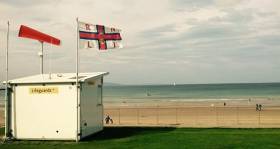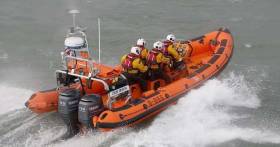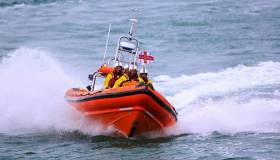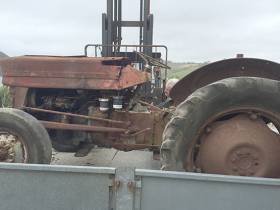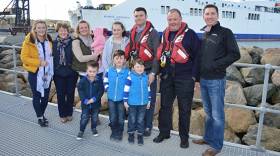Displaying items by tag: Lifeboat
Howth RNLI Rescue Fisherman Taken Ill Aboard Trawler
Howth RNLI launched at 3.45pm yesterday to reports of a fisherman in need of medical attention on a fishing boat 20 miles north of Lambay Island.
The casualty was removed from the fishing vessel and brought back to Howth to a waiting ambulance and transferred to hospital for treatment.
The request to launch came at 3.30pm and the Howth RNLI all-weather lifeboat proceeded 20 miles north of Howth and located the fishing trawler with the male casualty aboard. The Coast Guard helicopter was on scene to assist if necessary.
Weather was excellent with hazy sunshine and good visibility. The sea state was calm with little or no wind present.
Howth RNLI volunteers David Howard and Joss Walsh transferred to the fishing vessel to assess the casualty. It was decided to remove the fisherman to the lifeboat and return to Howth where an ambulance was waiting to take the casualty to Beaumont hospital.
Speaking following the call out, Ian Sheridan, Howth RNLI Second Duty Coxswain said: ‘Weather conditions certainly helped in the success of this operation today. We were pleased that our volunteer lifeboat crew’s training allowed us to very quickly locate and board the casualty vessel and take the fisherman back to Howth Marina and to an awaiting ambulance.’
An off-duty RNLI lifeguard has rescued a teenage boy this afternoon after he got into difficulty when bodyboarding in Portrush.
Conard McCullagh, a Senior RNLI Lifeguard on the Causeway Coast was cycling from Portstewart where he had been attending the North West 200 race paddock when at approximately 2pm he observed two teenagers on bodyboards in the water at Portrush West Strand.
Knowing the beach and the dangers of the water at Black Rocks, an area prone to rip currents, Conrad immediately sensed that the teenagers may get into difficulty and went to their parents who were on the shore. Conrad felt the teenagers were too far out in the water and advised their parents to wave them back in.
One of the teenagers, a 15-year-old girl managed to paddle her way in but the 13-year old boy struggled and indicated that he couldn’t get back in as the water was sucking him out fast.
Conrad immediately ran to the RNLI Beach Lifeguard Unit and grabbed a rescue board and went to the casualty and pulled him out of the water.
Once he had the teenage boy safely ashore, Conrad carried out casualty care checks to ensure the boy was ok.
Speaking following the rescue, Karl O’Neill, RNLI Lifeguard Supervisor said: ‘I would like to commend Conrad who wasn’t on duty this afternoon but used his RNLI skills and training to remain vigilant, spot the danger and go straight to the family when he suspected the teenagers may be in trouble.
‘This rescue serves as a reminder to us all that while we may be experiencing some good weather we still need to respect the water. It is a sunny warm day and the water appears calm and everything looks good on the surface but the reality is there is a lot going on underneath and the water can be very dangerous. The current the boy was bodyboarding in was simply too strong to paddle against. Thankfully, Conrad was able to go to the boy’s assistance today and we would like to wish him well following what must have been a frightening experience for him.’
RNLI lifeguards are on patrol from 11am-7pm at weekends on Benone Strand, Portrush West and East Strands, Whiterocks and Portstewart. They will take up full time daily patrol for the Summer on Saturday 25 June.
The RNLI’s advice for anyone planning a trip to the beach is to respect the water, check weather and tide times before you go and if planning to go into the water, swim at a lifeguarded beach, between the red and yellow flags. Avoid using inflatables in strong winds or rough seas.
If you get into trouble, stick your hand in the air and shout for help and if you see someone else in trouble, tell a lifeguard. If you can’t see a lifeguard, call 909 or 112 and ask for the Coastguard.
Skerries RNLI responded this afternoont to reports of swimmers in difficulty off a local swimming area known as The Springers.
The pagers sounded shortly before midday after Dublin Coast Guard received reports that a number of swimmers were caught in a rip current and were unable to get back to shore.
Skerries RNLI volunteers launched the lifeboat with David Knight at the Helm and crewed by Philip Ferguson, Emma Wilson and AJ Hughes.
Arriving on scene the crew discovered that there were four casualties in the water spread over a large area in between Red Island headland and Colt Island. The lifeboat quickly began recovering the casualties into the lifeboat.
With a large sea swell running and the casualties suffering from fatigue and early symptoms of hypothermia, it was necessary for one of the Skerries RNLI volunteers, Philip Ferguson to enter the water to assist them in getting on board.
Once all the casualties were on board the lifeboat returned to the station and recovered immediately to the warmth of the boathouse. Once inside the boathouse the casualties were assessed, monitored and treated for mild hypothermia but were all fit and well leaving the station.
Skerries Coast Guard unit and the Coast Guard helicopter Rescue 116 were also tasked. The helicopter stood by while the lifeboat recovered the casualties from the water.
Speaking after the call out, Gerry Canning, Volunteer Lifeboat Press Officer for Skerries RNLI said: ‘Rip currents are a major cause of accidental drowning on beaches across the world. Even if you know an area well, the currents may change based on the weather and tides. The speed of response is crucial in cases like this and our volunteers did an excellent job in getting there as safely and quickly as possible. ’
Fethard RNLI Launch to Kitesurfer in Difficulty off Duncannon Fort, Five Months After Similar Callout
In a callout that was virtually identical to one last January, Fethard RNLI was launched this afternoon (Sunday 8 May) to reports of a kitesurfer in difficulty off Duncannon Fort. As with the previous callout the kitesurfer made it ashore safely and was then picked up by the lifeboat’s landrover.
The Fethard lifeboat was launched at 4.20pm when a member of the public raised the alarm after seeing what they thought was a kitesurfer and two windsurfers in trouble near Duncannon Fort. However the two windsurfers were assisting the kitesurfer after he went into the water and was unable to get back up and was struggling. The windsurfers brought him closer to shore but with a strong tide were not able to bring him safely in themselves.
The Fethard lifeboat was en route to Duncannon beach to be launched when the kitesurfer managed to swim to shore himself. He then made his way from the beach inland where he was picked up by the lifeboat landrover. Conditions on the day were calm with good visibility.
Commenting on the callout Fethard RNLI Launching Authority Hugh Burke said, ‘This is the second callout of a similar nature in the last five months and about the sixth in the last three years. The tide in this area is extremely strong and many people are caught out by it, especially when the weather looks fine. The depth of the water shifts quite dramatically and people don’t realise they are on the edge of a major shipping lane. We would urge people to be extremely careful when they are in this area and to take proper safety advice. Thankfully the windsurfers were on hand to give assistance and a vigilant member of the public raised the alarm, however it could have ended very differently.’
Portaferry RNLI Issue Warning on ‘Dangerous’ Craft After Two People have Lucky Escape on Strangford Lough
Portaferry RNLI have issued a strong warning about the dangers of taking to the sea in unsuitable craft after a callout on Friday evening saw two men rescued from the freezing water after the inflatable dinghy they were in became swamped and they ended up in the water. The inflatable craft was fitted with an outboard engine and showed signs of patching on the tube where a repair had been carried out.
Volunteer lifeboat crew with Portaferry RNLI launched at 7.07pm on Friday evening (6 May) to Killyleagh some three and a half miles from the lifeboat station to two men in the water after their cries for help were heard from the shore. On arrival at the scene the lifeboat crew learned that the men, believed to be father and son, had been rescued from the freezing water by a local boat crew.
Commenting on the callout Portaferry RNLI Lifeboat Operations Manager Brian Bailie said, ‘These two men had a lucky escape. If their cries for help had not been heard this could have been an awful tragedy. These types of craft are totally unsuitable for the open waters off our coast. Conditions and tides can change at a moment’s notice and the sea must be respected. An inflatable dinghy which may be okay in a supervised indoor pool is not meant for the sea. Also in this case the addition of the power from the attached outboard engine made an unsuitable craft even more dangerous.’
‘We would urge people to be responsible and check that they are using the proper equipment when they take to the water. Conditions on the lough were quite calm on Friday with a force three and a slight sea, yet these people ended up in serious trouble. Thankfully they were wearing personal flotation devices but they spent some time in freezing cold water before their cries were heard and they were rescued.’
Helvick Memorial To Those Lost At Sea
The annual Mass in remembrance of all those lost at sea, and for their families will be celebrated in Helvick Lifeboat Station on Helvick Pier in Co.Waterford on Friday night of next week, May 13, by RNLI Station Chaplain Fr. Conor Kelly at 7.30pm.
A memorial in memory of those Lifeboat men who have lost their lives in the service of the RNLI saving others at sea on this coastline will be unveiled on Helvick Pier before the Mass begins. Nicholas Hannigan of the Dungarvan and Helvick RNLI Fundraising Branch said: “In 1852 the following brave local men lost their lives: Thomas Crawford, Capt Maurice Duggan, Laurence Lenihan, John Maher, Thomas McNamara, Maurice Mulcahy, Michael Raher and John Whelan. In 1895 Michael Hogan gallantly lost his. It is fitting that heroes from all around the Dungarvan Bay area should be remembered at home too and we hope their descendants can join us for the unveiling! Everybody is welcome to attend.”
Answer the RNLI’s Mayday Call & Help Save Lives at Sea
People across Ireland are being encouraged to help raise vital funds for the RNLI as part of the charity’s national annual fundraising event, Mayday.
The RNLI’s Mayday campaign runs through to the May Day bank holiday next Monday 2 May, with street collections and fundraising events taking place across the country.
RNLI lifeboat crew members are volunteers and remain on call 24 hours a day, and when the pager goes off they’ll drop everything to help somebody in need - often sacrificing their work and personal commitments.
David Howard, volunteer crew member at Howth lifeboat station, knows only too well the sacrifices that RNLI volunteers need to be willing to make, in order to drop everything and save lives at sea.
After months of secret preparation, David was all set to finally pop the question on Christmas Eve night. He had the specially designed ring in his hand and he was just waiting for his girlfriend to come home so he could get down on one knee and ask her to marry him – but then his pager beeped.
Abandoning his plans, David dashed to the lifeboat station. One minute he was plucking up the courage to propose, the next minute he was in the lifeboat out at sea saving a fisherman with head injuries.
On Christmas morning, David was finally able to get down on one knee and ask his girlfriend to marry him. And, of course, she said yes!
David said: ‘When the pager beeped, I didn’t think twice before dashing straight to the lifeboat station. Like all of the RNLI’s volunteer crew members, I know that when the pager beeps, every second counts, so you have to stop whatever you’re doing to go and save lives at sea.
‘The way I was going to propose was carefully planned to the finest detail, but all of those plans went out of the window when the pager went off. Luckily, I was able to pop the question the next day, and I was over the moon when she said yes.’
Every day is Mayday for the RNLI’s lifeboat crews, who are specially-trained volunteers, on-call 24/7 to save lives at sea. Whatever the weather, day or night, they are ready to drop everything and launch the lifeboats to rescue anyone in danger at sea. But, as a charity, the lifesaving service they provide is only possible thanks to the generous support of the public.
Many of the Mayday fundraising events have a yellow welly theme, in a nod to the essential kit that the RNLI’s lifeboat crew members wear on their feet when they go out to sea to save lives.
The charity is encouraging people to show their support by using the hashtag #MaydayEveryday on social media, buying and wearing a Mayday yellow welly pin badge, hosting or supporting a fundraising event or donating online.
Money raised through Mayday fundraising events will support the RNLI’s lifesaving work – it could be used to fund crew training, buy new crew kit, or contribute towards the running costs of a lifeboat station.
Visit RNLI.org/Mayday to donate, to order a pin badge or to see what other ways you can support the RNLI’s Mayday campaign.
The RNLI operates 45 lifeboat stations around Ireland. Last year, RNLI lifeboat crews in Ireland launched 1,098 times bringing 1,244 people to safety.
A UK Agricultural Engineering lecturer is to travel to Union Hall, Cork this July to undertake a challenge to rebuild a Massey Ferguson tractor in 24-hours, with a little help from colleagues and friends. The tractor will then be raffled off to raise funds for Union Hall RNLI.
Michael O’Sullivan is a lecturer in Wiltshire College, England and has a home in Union Hall, where his father was born. Michael approached Union Hall RNLI some months ago with his unique fundraising idea and asked them if they could source a dilapidated tractor for the 24-hour challenge. They could and they did and plans are now in place for the 24-hour rebuild on Wednesday 13 July 2016 on Keelbeg Pier in Union Hall.
Commenting on the novel fundraiser Pamela Deasy, Union Hall RNLI Lifeboat Press Officer said, ‘This wonderful project, to be carried out with the help of the local community, will raise much needed funds for Union Hall RNLI. We are passionate about three things in this part of the world; the sea, our sport and the land and this project encompasses two out of three of them.
‘Some years ago we saw a need for a lifeboat service here and we approached the RNLI to consider our proposal. Even before there was a lifeboat in Union Hall the community raised funds for the charity. The awful tragedy with the Tit Bonhomme in 2012 brought home to us how unpredictable the sea can be and how many families have lost loved ones to it. In 2014 the RNLI established a lifeboat station in Union Hall with an Atlantic class inshore lifeboat on a two year trial. Since that time the volunteer lifeboat crew has responded to 17 callouts and brought 21 people to safety.’
The parts for the tractor are being donated to the project by AGCO and it is hoped to be able stream the 24-hour challenge live online.
Wexford RNLI Rescues Lone Sailor After Yacht Hits Sandbank
Wexford RNLI rescued a lone sailor yesterday evening after his yacht hit a sandbank in heavy seas off Rosslare Point.
Volunteer lifeboat crews from Wexford and Rosslare Harbour RNLI were launched at 6.35pm following reports that a 26ft yacht had hit a sandbank somewhere off Wexford.
As little information was given on the location, both the inshore lifeboat from Wexford and the all-weather lifeboat from Rosslare Harbour proceeded to the Wexford Bar area which is known for its treacherous seas over a myriad of sandbanks.
Once on scene, Wexford RNLI spotted the vessel 100m north of Rosslare Point on Wexford Bar. Two crew members Damien Foley and David Maguire climbed onto the yacht to find a lone sailor tired from his 14 hour voyage from Fishguard.
With the yacht at anchor, the crew battled to release the anchor with waves crashing over them. The anchor broke and the yacht escaped been broken up.
The lifeboat helmed by Sinead Casey and with crew member Simon Casey also onboard, took the casualty vessel under tow and navigated its way through difficult lumpy seas out to deep water where the tow was dropped.
The crew members onboard the yacht then steamed the vessel over a dirty Wexford bar under the watchful eye off Rosslare Harbour RNLI.
The sailor and his yacht were safely brought alongside at Wexford Quay.
Speaking following the call out, Sinead Casey, Wexford RNLI helm said: ‘This was a challenging rescue but our crew who are highly skilled and trained managed to take the vessel under their control much to the relief of the tired sailor who was on a voyage from Wales to Scotland. Thanks to the great team effort by the volunteers from both Wexford and Rosslare Harbour, the sailor and his yacht were rescued from very difficult seas.’
A Fascinating Lifeboat Man
I said words in tribute to a Lifeboatman on radio this week that I have never said before as I introduced my programme (scroll down the page for the podcast). I meant them and I was honoured to be able to speak them about a man who has spent 42 years with the RNLI at what I regard as a famous lifeboat station. This is what I said on the programme:
“Thank you for joining me on this marine voyage in which we will hear a particularly interesting interview with a lifeboatman and the changes he has experienced in a 42-year career with the RNLI, Tony Kehoe of the famous Rosslare Lifeboat Station talks frankly about a life rescuing people in trouble at sea in a way in which I’ve never before heard a lifeboatman being so direct and clear about the good, the bad and the tough aspects of a career aboard lifeboats.”
Tony spoke of rescue work in older lifeboats and how they could be hard to handle! And about a time when “someone knocked on your door in the middle of the night and said you were needed at the lifeboat…” He talked of the changes, particularly in the speed of lifeboats getting to the scene of a rescue or tragedy faster and requiring quicker responses by the crew to a variety of issues arising from that speed over the water and also, what it does to the body physically, when hitting waves at speeds of 16 knots and more, rather than 8 knots in older boats.
He comes of a family with huge commitment to the lifeboat service and two of his sons also joined Rosslare Station. I was very impressed by his interview and particularly what he told Niamh Stephenson, also of the RNLI who did the interview for the programme, about the most important requirements for a good lifeboat crew ---- “being part of a team, trusting each other..” and his final wish for those who carry on the service: “Mind yourselves….”
I am confident that you will enjoy listening to his interview and will appreciate even more, the value of the lifeboat service when you have heard it.
In that regard I commend to you May Day, Sunday May 1, at the National Concert Hall in Dublin, where I intend to be, to hear the Wexford Sinfonia Orchestra play their five-part suite, ‘HEROES OF THE HELEN BLAKE,’ a tribute to the men of the Fethard-on-Sea Lifeboat who died in the rescue service to the sailing cargo ship, Mexico. The members of the orchestra range in age from 14 to 80. The performance will begin at 3 p.m. MAY DAY is the annual Fundraising Day for the lifeboats. Tickets are €20, students €15 and can be bought at the Box Office at the Concert Hall or online at www.nch.ie Do support the lifeboats on this day….
THIS ISLAND NATION reports on the maritime traditions, culture, history and modern marine developments in our island nation. Your comments are always welcome. Email: [email protected]



























